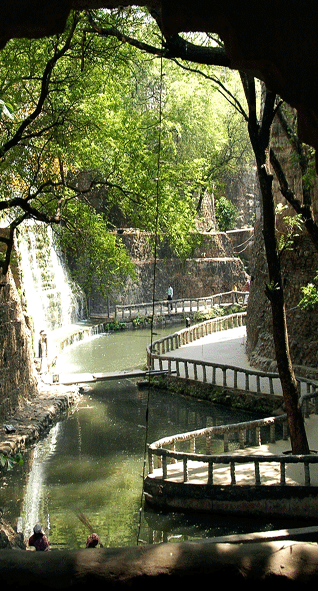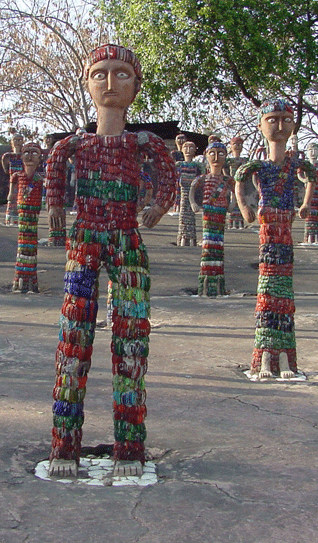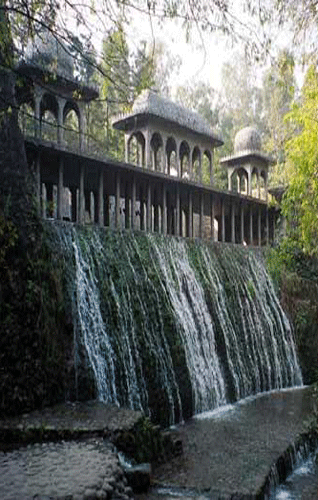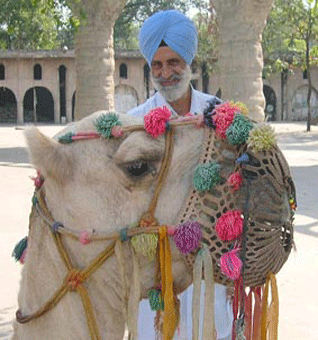Travel
Chandigarh's Rock Garden
by JOHN GODDARD
CHANDIGARH, PUNJAB
To buy a ticket you must stoop to a child's height.
The grilled window comfortably serves an 8-year-old, meaning that most adults must bend or crouch to pay the 50-cent fee.
The entrance leads to courtyards where fossilized boulders pose like abstract sculptures.
A path narrows between stone walls, then widens again to reveal tree-root murals, mini cliff-top villages and walkways past cascading waterfalls.
Strangest of all, on stone platforms, mythic creatures assemble like small armies, their bodies fashioned from urban waste - broken tiles, shattered pottery, chipped bangles and discarded electrical plugs.
"Nek Chand's Rock Garden", the government calls the place, said to be India's top tourist attraction after the Taj Mahal, but still little-known except to Indians.
Nek Chand himself dubs his charming fantasyland, covering 10 hectares at the edge of Chandigarh, capital of India's northwest Punjab state.
"It started as a hobby," the 86-year-old folk artist says one recent evening in his modest way. "For many years, I kept it secret because I never thought people would like it."
The exhibition stands as testimony to the creative spirit in every human being, no matter how humble.
Chand grew up a Sikh peasant boy north of Lahore (now in Pakistan).
In 1947, when he was 23, he found himself on the Pakistan side of a newly divided country and made a terrifying three-week trek to the newly-carved Indian nation.
In 1951, he married and moved to Chandigarh. It was a construction site then. French architect Le Corbusier was building a new state capital for Punjab that was to symbolize Indian progress and modernity.
His plan called for a geometric city. It featured symmetrical interlocking sectors with wide boulevards, artificial lakes and a central cluster of concrete, futuristic administrative buildings.
Chand took a job as road inspector.
For seven years, he dutifully helped impose the European architect's straight lines. Then an inner impulse took over. For reasons he cannot fully explain, Chand started building his own private fantasy city of curves and spontaneity.
"God was pushing me but I didn't realize it then," he says vaguely of his motivations. "It was God's gift."
In 1958, at the edge of Le Corbusier's master plan, Chand fenced off a jungle tract with rusty barrels.
On his bicycle, from surrounding hills, he gathered rocks that struck his fancy. From flattened villages he recovered pottery and broken tiles, and from new construction projects helped himself to cement.
"I came after 5 p.m. and worked until 9 p.m., four hours every day," Chand recalls of his feverish work. "During holidays, my wife (Kamla) helped me, working with me the whole day. She liked what I was doing."
For 13 years, keeping his day job, Chand worked after-hours undetected. To keep off the sun and rain, he built a low-slung workshop. To fend off snakes and mosquitoes, he stoked smoky fires.
Landscaping would come later. Mostly, he created sculptures from concrete, bicycle frames and recycled waste, leaving the finished figures wherever he pleased.
In 1973, city workers stumbled on the hideaway and told his secret. But rather than punish Chand, civic authorities embraced his vision.
"They liked this civilization of waste," he says.
Newly appointed as "artistic director," Chand guided a staff of more than 30 to expand his vision.
Working without sketches or drawings they built courtyards, partitions and display platforms. They created an undulating landscape of narrow passageways, open spaces and waterfalls.
On Jan. 24, 1976, the first phase and part of the second formally opened to the public. The third and final phase, begun in 1993, is to be completed next year.
In some ways, Phase I seems overly subtle, the visitor left to perceive fantasy gods and goddesses in rocks and mosaics. By contrast, Phase III appears overly ambitious, with such amusement-park frills as giant swings, ice-cream stands and a camel ride.
Phase II, the core of the exhibition, displays Chand at his most dramatic and expressive.
His waterfalls and cliff-top villages conjure up the nostalgia of his lost childhood. His armies of animal- and humanlike figures, their lines as simply drawn as New Yorker cartoons, convey a range of deep human emotion - from delight to horror.
The world's architects still come to Chandigarh to see Le Corbusier's futuristic city. But most tourists come to marvel at Nek Chand's folk-art kingdom.
[Courtesy: Toronto Star]
June 30, 2010
Conversation about this article
1: Satvir Kaur (Boston, MA, U.S.A.), June 30, 2010, 9:01 AM.
Memories of my childhood. I loved this place. Every time we went to Chandigarh, we asked our father to leave us at the Rock Garden and then he could attend to his chores. We never got bored of it, even if it was three or four times a year.
2: Taran (London, United Kingdom), June 30, 2010, 5:49 PM.
I grew up in Chandigarh and I'm a Chandigarhian at heart. I have been at the Rock Garden as a child many times or with anybody visiting us to show them around. It has been a great contribution by S. Nek Chand ji to this city and its citizens. I heard a rumour that they were going to build a replica of the Rock Garden somewhere in France or maybe in Canada! I think it's a masterpiece and a must-visit attraction of the city.
3: Plate (U.S.A.), June 30, 2010, 7:33 PM.
I visited the Rock Garden almost every year till Grade 9 with my parents or as part of a school trip. I have nothing but good memories of that place. It was a place I could safely get lost in and dream. What a wonderful place created with mostly stones, rocks or other bio-degradable materials. This is a well kept secret of Punjab and a must-see for any tourist visiting India. I hope they build a website and sell tickets online so visitors from around the world can arrange their tickets in advance. The website can also be used as an educational tool to educate young kids about the environment and creativity. As I recall this Garden, I realize that money alone cannot build institutions or works of art, all one needs is creativity and a heart full of sincere effort.






